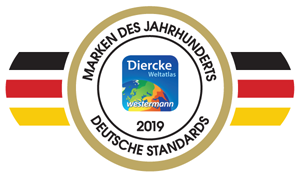Europe - Empires at the end of Charlemagne’s reign circa 814
Middle Ages
978-3-14-100890-6 | Page 58 | Ill. 1

Overview
Hardly any ruler has shaped the early medieval history of Europe to such an extent as Charlemagne. Charlemagne was king of the Frankish Empire and at the same time conqueror of many territories. His empire encompassed almost all of Western Europe. Because of his power, he was regarded as a mighty ruler, even as a kind of "Father of Europe".
In the footsteps of the father
When Charlemagne took over the rule of Francia in 768 AD, it encompassed almost all of what is now France and half of what is now Germany. Charlemagne's father Pepin III, the Short, had deposed the Merovingian king in 751 and had himself elected king as well as legitimised by the Pope. In return, he gave the Pope territories that he had conquered from the Lombards, thus laying the foundation for the Papal States ("Donation of Pepin"). In terms of home affairs, he succeeded in integrating the duchies of Bavaria, Alemanni and Thuringia, which were distinguished by dialects, customs, and traditions, more strongly into the Frankish sphere of power and obliged them to follow their army.
Establishment of Christianity
By eliminating all previously independent duchies and dominions, Charlemagne succeeded in creating a uniformly organised Frankish Empire, which was secured by the establishment of Frankish border markers and Frankish spheres of influence. Law texts (capitularies) and the records of older popular laws bear witness to his legislative activity. He supported episcopal schools and monasteries, attracted important scholars to his court, ensured the preservation of Latin traditions and brought about a cultural renewal ("Carolingian Renaissance") in Western and Central Europe by merging ancient heritage and Christian religion after the dark centuries of migrations and the early Middle Ages.
The epochal importance of Francia was based on the shift of the political centre from the Mediterranean to the areas north of the Alps. After Charlemagne was crowned emperor of a Roman Empire renewed under Christian auspices in Rome on 25 December 800, his status as patron and head of all Christians was completely unchallenged. (It was only under Otto the Great, who was crowned emperor in Rome in 962, that the power struggle between pope and emperor began, which later led to the Investiture Controversy).
Charlemagne's expansion of power
His son and successor Charlemagne crossed the Alps five years after his accession and defeated the Lombards. A little later, in 778, he fought against the Spanish Moors and established the Spanish Marches in the north-east of the Iberian Peninsula. In 787 he deposed the Bavarian Duke Tassilo III, as a result of which Bavaria lost its autonomy. He succeeded in securing the eastern borders by subduing the Avars (791-805), a warrior horde from Asia who had invaded Bavaria, and by his battles against the Bohemians, Sorbs and the Lutizes (until 812). At the same time, he defended the border with Denmark in the north. The greatest military campaign of his reign, however, were the wars against the Saxons, which began in 772 and, after numerous battles, revolts and skirmishes, ended only in 804 with the subjugation of the Saxons and their conversion to Christianity.
Partition of the Empire and decline
When Charlemagne's grandsons divided the empire among themselves in the Treaty of Verdun in 843, Louis the German received the land east of the Rhine and the Aare as the realm of the East Franks. Further divisions followed through the Treaties of Meerssen (870) and Ribemont (880). After a brief restoration of imperial unity in 885, the final division into the West Frankish Empire, the East Frankish Empire, Burgundy, and Italy occurred in 887. This division sealed the end of Francia and, at the same time, marked the beginning of an independent development of the sub-kingdoms.
The decline of the empire following Charlemagne's death favoured plundering campaigns undertaken by Vikings from Scandinavia along the coast of Europe starting at the end of the 8th century. Norwegian Vikings first raided the north-east coast of England and occupied northern Scotland and Ireland. Some moved south along the Atlantic coast and reached the Mediterranean coasts through the Strait of Gibraltar, others occupied the Shetland Islands, the Faroe Islands and Iceland. Danish Vikings attacked England and the Frankish Empire, later conquering Normandy. Swedish Vikings crossed the Baltic Sea and established various kingdoms along the coasts populated by Slavs.




